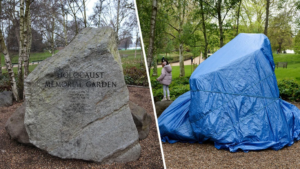1921 massacre obliterated a prosperous Black community, marking one of American history’s darkest chapters of racial violence
HOUSTON, US
It has been more than 100 years since the massacre that obliterated a prosperous Black community in Tulsa, Oklahoma, yet families of those killed in one of American history’s darkest chapters of racial violence are still waiting for reparations.
The massacre started on May 31, 1921, in the Black north Tulsa neighborhood of Greenwood, known as the Black Wall Street.
It lasted for two days and saw more than 1,400 businesses and homes burned to the ground. The destruction left nearly 10,000 residents homeless.
Official historical records indicate that 26 Black people and 10 white people were killed, but historians today estimate that number to be closer to 300 people, most of them Black.
“Reparations need to be paid,” Terry Baccus, a descendant of one of the victims, said on the 102nd anniversary of the riots.
The tragedy, also known as the Tulsa race riot of 1921, should never be forgotten, he stressed.
“It’s important that the loved ones be recognized, that the descendants be recognized, that the ancestors be recognized,” he told TV network KTUL.
The tragedy unfolded after Dick Rowland, a young Black man, was accused of assaulting a white elevator operator named Sarah Page on May 30, the day before the riots began. An article was run in the Tulsa Tribune newspaper the following day, saying that Rowland had tried to rape Page. An editorial in the newspaper then called for the lynching of Rowland planned for that night.
Black and white residents gathered in two opposing mobs at the courthouse where Rowland was being held, with a confrontation between a Black man and a white protester culminating in the white man’s death. Historians say that ultimately ignited the massacre.
Long wait for recognition
Despite the severity of the Tulsa race massacre, the event was barely mentioned in history books until 1997, when a state commission was formed to document the incident.
Members of the commission gathered accounts of survivors who were still alive, collected documents from individuals who witnessed the massacre but had since died, and scholars used the accounts of witnesses to locate a potential mass grave to try and uncover more evidence of a higher death toll.
The commission’s final report was published on Feb. 28, 2001 and suggested that the state of Oklahoma pay $33 million in restitution, including to the 121 surviving members who had been located at that time, but no legal action was ever taken to enforce the payment, according to Encyclopedia Britannica.
However, in April 2002, a private religious charity, the Tulsa Metropolitan Ministry, paid a total of $28,000 to the survivors, which came to a little more than $200 each.
In 2010, the John Hope Franklin Reconciliation Park was opened in the Greenwood District to memorialize the massacre. The park was named after historian and civil rights advocate John Hope Franklin, whose father survived the riot.
Many Tulsa residents welcome visitors and remember the tragic day in American history, including Baccus, who said there is an abundance of opportunities in the Greenwood District for people to learn about the historical significance of the race riots.
“Tell your loved ones, tell those of your family members that’s from out of state, ‘Hey, come to Greenwood, learn of Greenwood, learn what took place in Greenwood,'” urged Baccus.
On Tuesday, the oldest living survivor of the Tulsa race massacre, 109-year-old Viola Fletcher, released a book with her grandson, Ike Howard, titled Don’t Let Them Bury My Story, which talks about how the race riots affected her life.
“She knows the more people that know the story, the more people that will, hopefully, be held accountable,” Howard said at a news conference, according to the Tulsa World newspaper.
“So she wants that accountability, she wants justice, she wants people to know the history so it doesn’t repeat itself.”
While the book covers topics beyond the race riots, Howard said the crux of the story focuses on how the events shaped the family’s history.
“It’s about Viola Ford Fletcher, her thoughts about different things, and different things that happened to our family, generational trauma that was passed on because of the race massacre,” Howard added.
Earlier this month, Fletcher attended a court hearing about a continuing lawsuit over reparations for families affected by the massacre. The publication of the book was delayed to allow Fletcher to include her thoughts on the court proceedings.
A Tulsa County district judge has yet to decide on whether the last living survivors of the massacre can move forward with the lawsuit.





